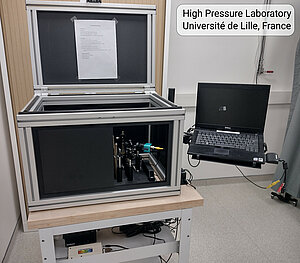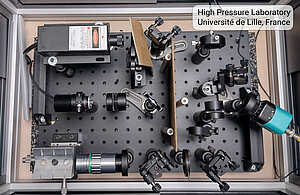Ruby fluorescence spectrometer
Ruby fluorescence spectrometer
Ruby fluorescence is used to evaluate pressure in experiments in diamond anvil cells.
The red color of rubies arises from traces chromium atoms in substitution of aluminum. Cr3+ ions emit a red fluorescence when stimulated by both visible and ultraviolet light. The are two fluorescence lines, R1 and R2, at 694.25 nm and 692.7 nm, respectively, under ambient conditions of pressure and temperature. The wavelength of those lines moves towards higher values with increasing pressure.
Our ruby fluorescence system uses a blue laser of 100 mW, a 20x plan apo Mitutoyo objective, and a portable StellarNet spectrometer. Rubies are loaded along with the sample in the sample chamber. When lit with the laser, rubies emit a fluorescence spectrum which we analyse using the spectrometer to locate the position of the ruby R1 line.
The setup is set on a movable cart to be able to move it within the lab (and elsewhere) as needed.


